Introduction
Music tattoos are more than skin-deep—they represent rhythm, emotion, identity, and passion. Whether you’re a musician, a fan, or someone deeply touched by a single lyric, music tattoos beautifully blend sound and symbolism into body art. From delicate notes to entire compositions, these tattoos offer a creative way to wear your love for music with pride.
In this post, we’ll explore the meaning behind music tattoos, how to choose the right design, where to place it, tips for aftercare, and more. Whether you’re thinking of a subtle treble clef or an entire symphony across your arm, let this guide help you create body art in perfect harmony.
How to Choose the Right Music Tattoo
Choosing the right music tattoo means tuning into both your personal connection to music and the visual elements that best represent that bond. Begin by reflecting on what music means to you. Is it a career, a form of healing, a memory, or a daily motivator? Your design should reflect that emotional depth.
Start by identifying the style that speaks to you. Minimalist tattoos like a single note, waveform, or lyric fragment offer quiet elegance. More complex designs might include instruments, portraits of favorite artists, or entire sheet music compositions. Consider if you want a tattoo that’s literal—like a piano or a drum—or more abstract, such as soundwave art or an image inspired by a favorite album.
If lyrics resonate with you, choose lines that hold long-term meaning. Avoid overly trendy quotes unless they’re deeply personal. Font choice also matters—classic script, bold typewriter fonts, or handwritten lyrics each convey a different tone.
Think also about the emotional tone of your design. Is it nostalgic, celebratory, or solemn? A memorial tattoo might incorporate a date, name, or image of a loved one’s favorite instrument or song. A motivational piece could feature an inspiring line from a track that changed your life.
Lastly, collaborate closely with your tattoo artist. Share your story, your song choices, and any reference images. A skilled artist can turn your personal connection into a design that’s not only beautiful but meaningful and one-of-a-kind.
Tattoo Placement Guide for Music Tattoos
Placement is a crucial part of the tattoo design process, especially for music tattoos where flow and form matter just as much as symbolism. The right placement can enhance the impact of your tattoo and align with how you want it to be seen and felt.
Forearm: This area is ideal for lyric lines, sheet music, or soundwaves. It’s flat, visible, and allows for horizontal flow, making it perfect for storytelling tattoos or pieces that follow a timeline.
Wrist and Hand: Great for small music symbols like treble clefs, bass clefs, or initial notes. These tattoos are often discreet and meaningful, acting almost like reminders of a deeper connection to music.
Upper Arm or Shoulder: Perfect for larger, more detailed music-themed pieces. Instruments, portraits of favorite artists, or elaborate staff notations look fantastic here, and the curve of the arm allows the design to flow naturally.
Chest and Ribcage: These areas are ideal for personal, intimate tattoos such as memorial pieces or deeper symbolic designs. The ribcage is often chosen for lyrics close to the heart—literally and figuratively.
Back: Offers a broad canvas for ambitious tattoos like full compositions, band tributes, or album artwork. Back pieces can combine multiple music elements into a single, powerful visual.
Leg and Thigh: These areas are more subtle and are often used for creative arrangements, including microphones, instruments, or abstract representations of sound and rhythm.
When choosing placement, consider how visible you want your tattoo to be, whether you want to expand the design in the future, and how it aligns with your lifestyle or profession.
Popular Music Tattoo Designs
Music tattoos come in a variety of styles, each resonating with the deep connection individuals have to melodies, lyrics, and rhythms. Here are some of the most popular music tattoo designs:
1. Musical Notes and Symbols
Simple yet iconic, tattoos featuring treble clefs, bass clefs, or individual musical notes are timeless expressions of a passion for music. These designs capture the essence of music in its purest form, representing harmony, creativity, and rhythm.
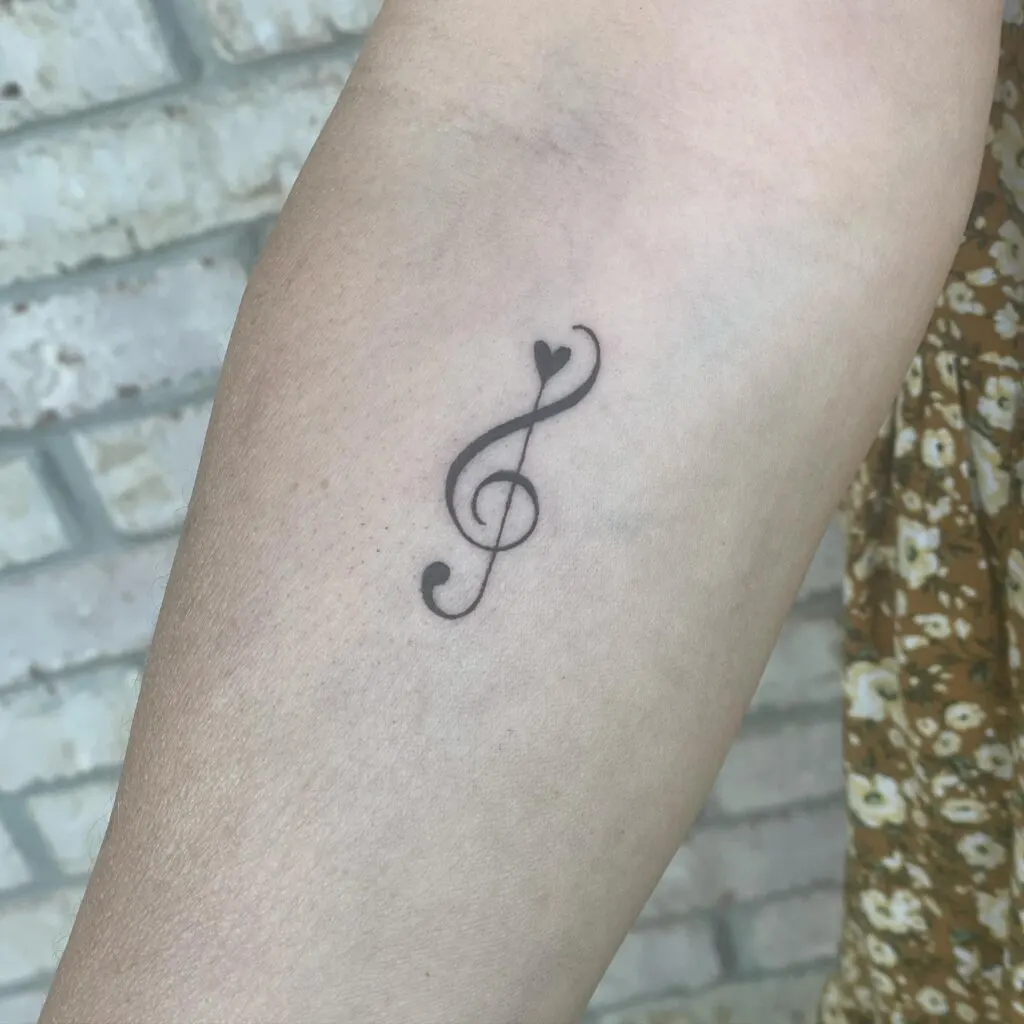
Their clean, minimalist style makes them versatile and easy to personalize, whether as standalone symbols or part of a larger composition. Perfect for placement on the wrist, ankle, or behind the ear, these tattoos suit those seeking a subtle yet meaningful tribute to their love for music. Treble and bass clef tattoos, in particular, hold universal appeal for music enthusiasts of all kinds.
2. Instruments
Instrument tattoos, featuring designs like guitars, pianos, violins, or drums, are striking representations of a deep love for music. These tattoos symbolize not only a passion for melodies but also a personal connection to playing or listening to a specific instrument.
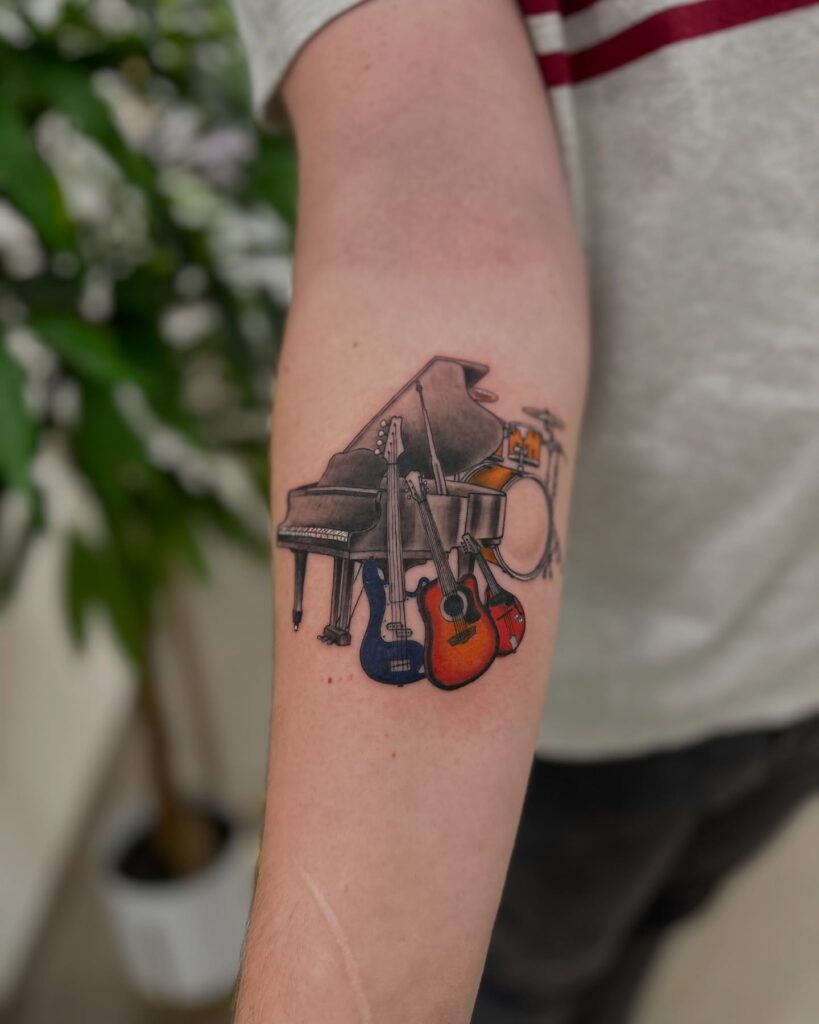
Whether it’s a sleek electric guitar, a grand piano, or a classic violin, each design reflects the unique bond between the wearer and their musical journey. Intricate details like strings, keys, or drumsticks add character and realism, while complementary elements like notes or soundwaves enhance the design. Perfect for musicians and music enthusiasts alike, these tattoos are timeless tributes to the art of sound.
3. Song Lyrics
Powerful song lyrics or quotes are a timeless tattoo choice, allowing individuals to carry meaningful words that have profoundly influenced their lives. These tattoos symbolize personal stories, emotions, or life-changing moments tied to music. Often paired with artistic fonts or imagery, such as musical notes, flowers, or instruments, these designs enhance the aesthetic and emotional impact.
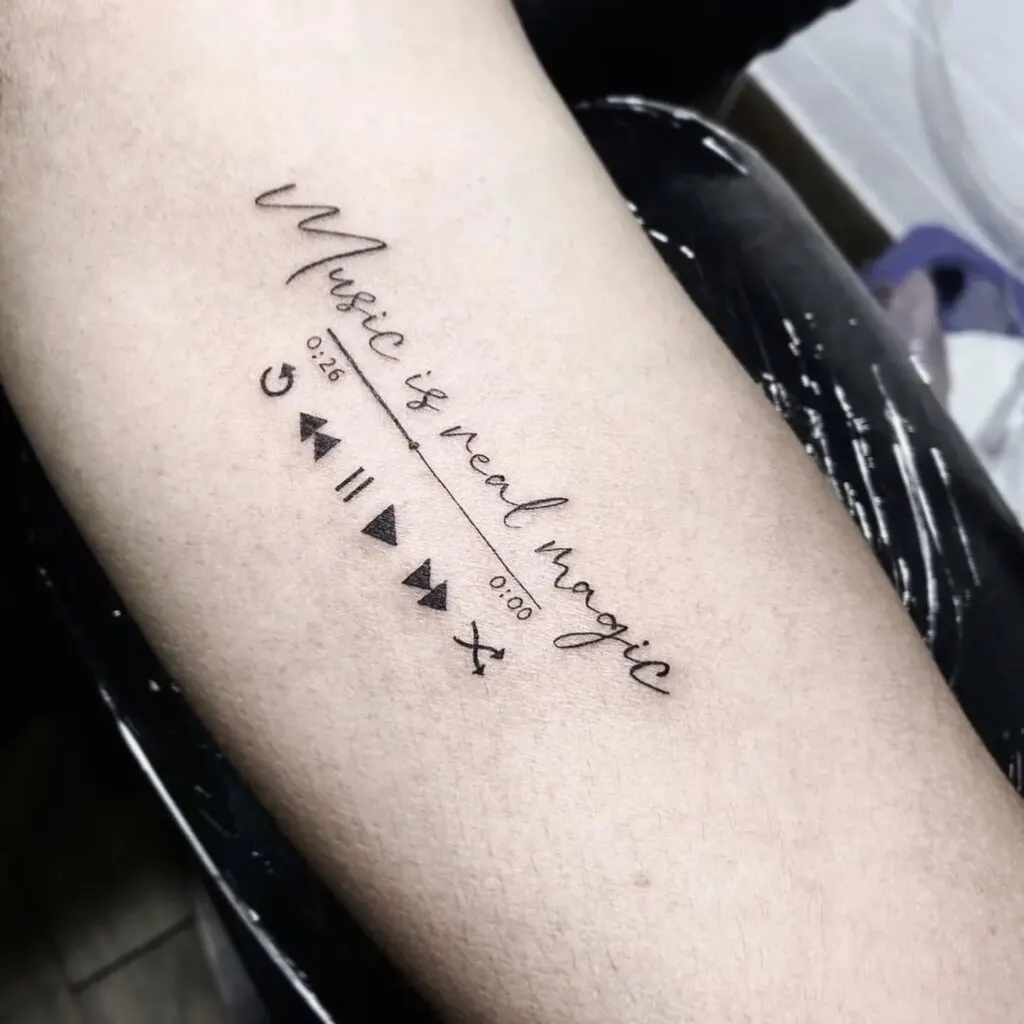
The versatility of lyric tattoos makes them suitable for various placements, from forearms and ribs to collarbones and ankles. Whether a single line or an entire verse, these tattoos serve as a constant reminder of inspiration, comfort, or motivation drawn from the art of music.
4. Soundwaves
Soundwave tattoos are a modern and deeply personalized form of body art, capturing the unique waveform of a loved one’s voice, a favorite song, or a cherished sound. These designs symbolize moments and memories, making them a powerful expression of emotion and connection. Each tattoo is as unique as the sound it represents, adding an intimate and creative touch.
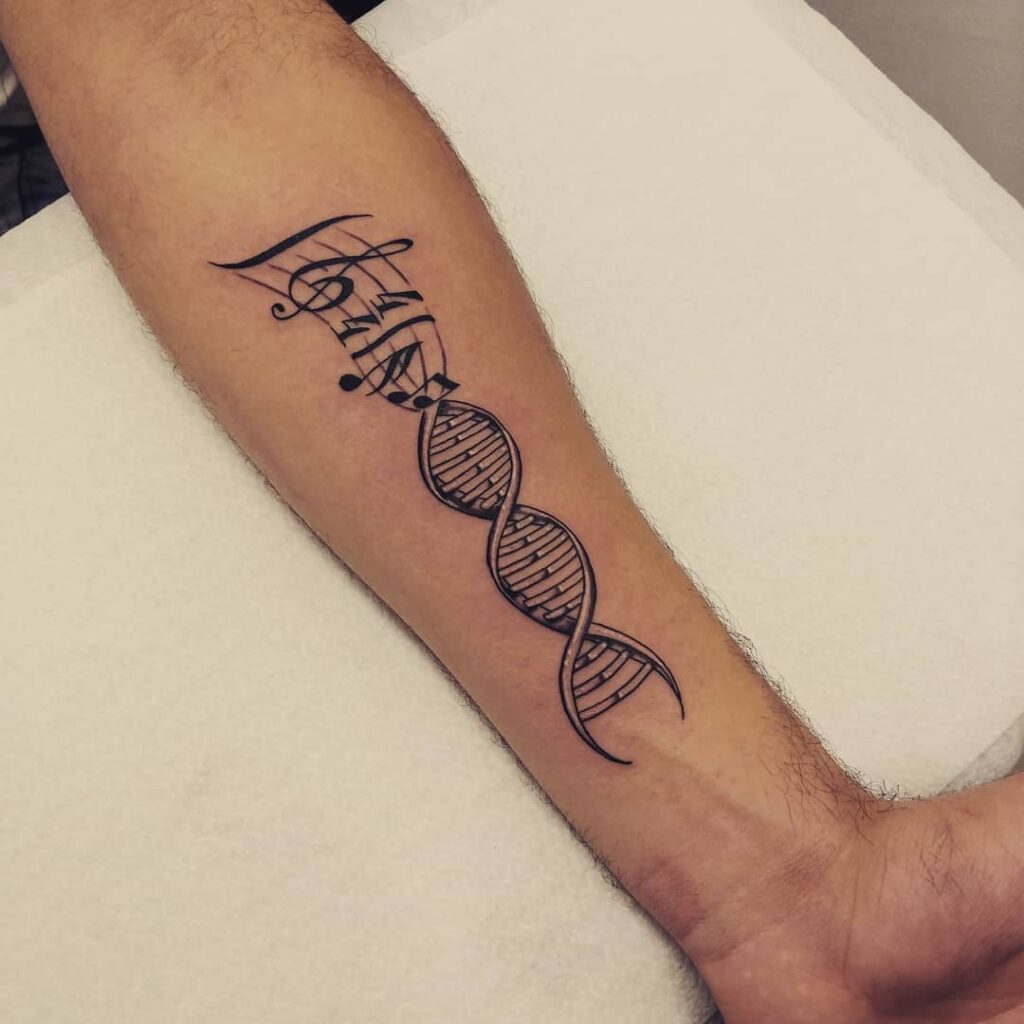
Whether showcasing the chorus of a life-changing song or the voice of a loved one saying “I love you,” soundwave tattoos are ideal for meaningful and innovative designs. Perfect placements include the forearm, wrist, or behind the ear, ensuring their distinct significance.
5. Headphones and Earbuds
Headphones and earbuds tattoos are ideal for individuals who live and breathe music, embodying their deep connection to the melodies that accompany their daily lives. These designs symbolize the personal and intimate bond with music, often representing how it serves as a soundtrack to emotions, memories, and moments.
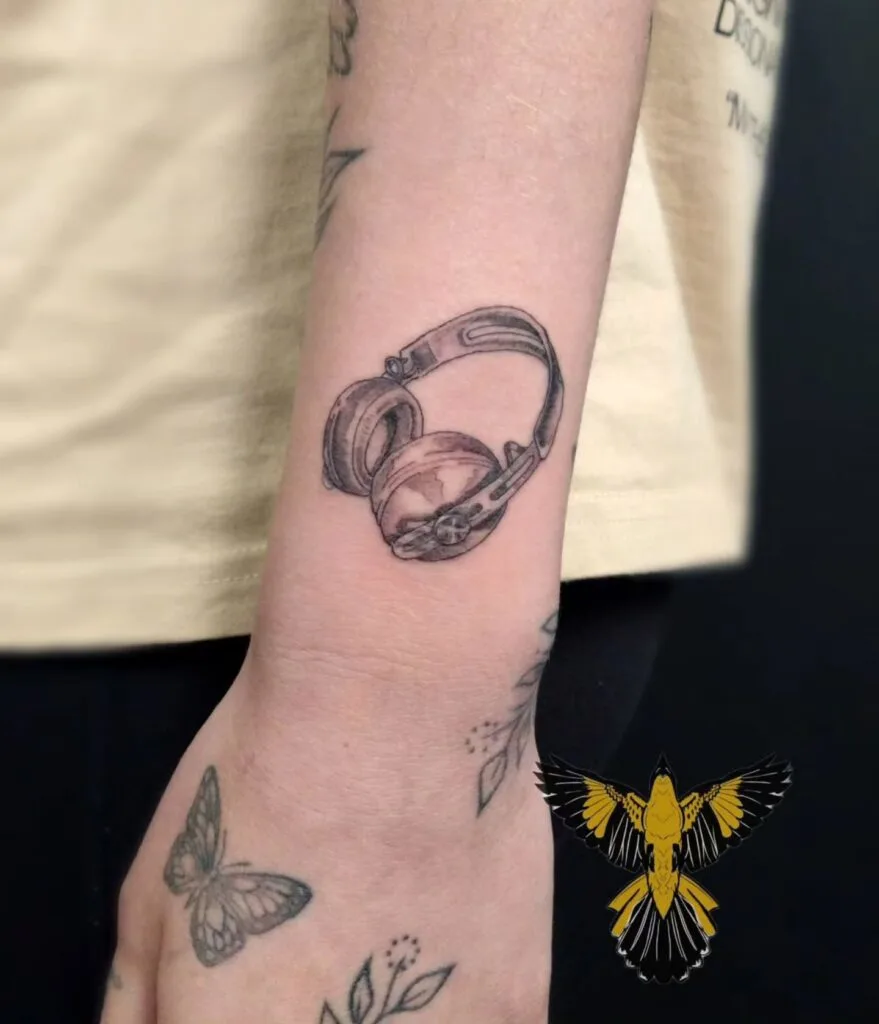
Popular among audiophiles and music enthusiasts, these tattoos can be minimalist, such as simple outlines, or intricate, featuring realistic shading and details. Whether placed on the wrist, forearm, or behind the ear, headphones and earbuds tattoos are a meaningful tribute to the power of music as a constant companion and source of inspiration.
6. Record Players, Vinyl, and CDs
For fans of vintage aesthetics, tattoos of record players, vinyl records, or CDs beautifully capture the timeless joy of experiencing music in its physical forms. These designs evoke nostalgia, celebrating an era when music was not just heard but also felt through tangible mediums.
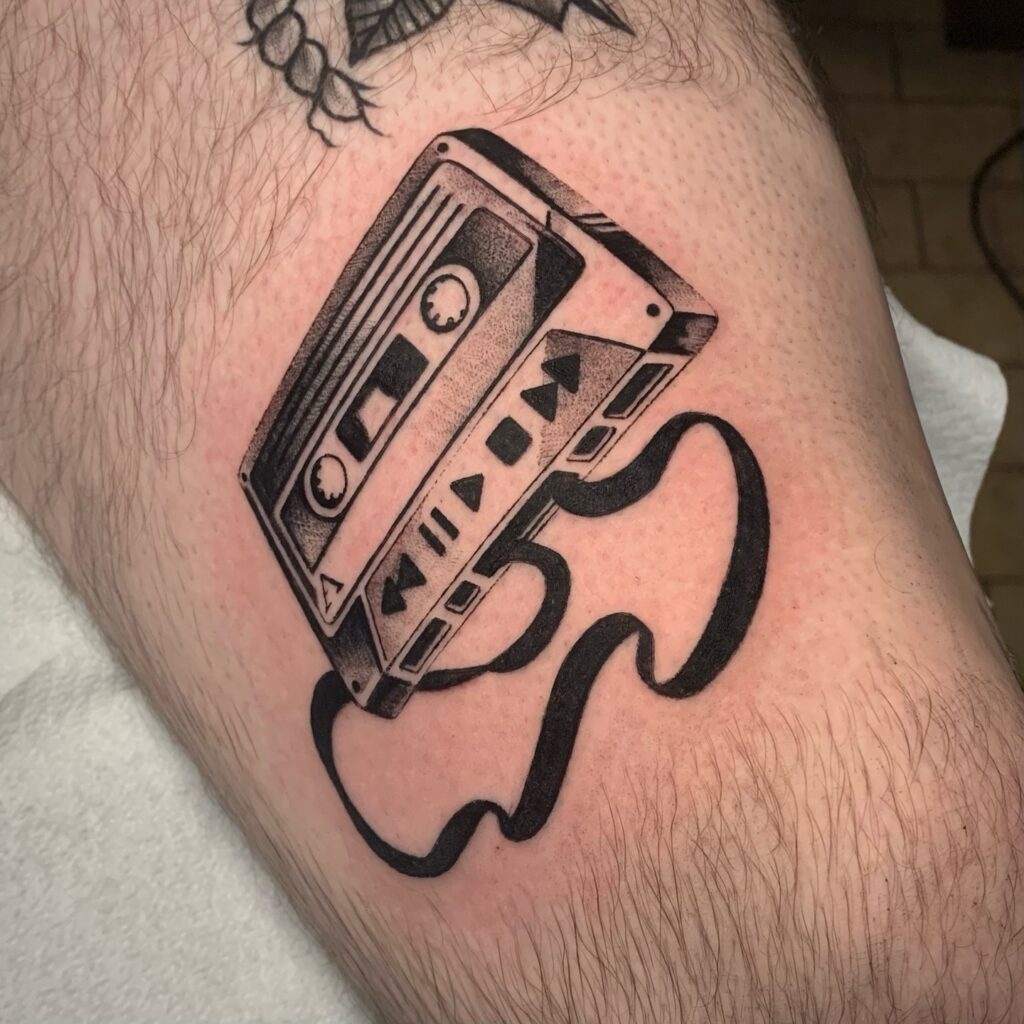
Record player tattoos often feature intricate details like spinning discs and stylized arms, while vinyl records symbolize the enduring charm of analog sound. CD designs can highlight the vibrant iridescence of discs, adding a modern retro touch. Perfect for music enthusiasts, these tattoos are a tribute to the artistry and emotional connection of classic music formats.
7. Band Logos
Devoted fans often express their admiration by choosing tattoos featuring the logos of their favorite bands or artists. These tattoos go beyond simple designs—they serve as powerful statements of loyalty and appreciation for musicians who have profoundly influenced their lives.

Whether it’s the iconic symbol of a rock band or the minimalist logo of a beloved artist, these tattoos carry deep personal meaning. They often represent cherished memories, concerts, or life-changing songs. Perfect for visible placements like the forearm or wrist, these tattoos become lifelong tributes to the emotional impact and connection created through music.
8. Sheet Music
Intricate and elegant, sheet music tattoos beautifully showcase a specific piece of music or a favorite song, making them a sophisticated choice for music enthusiasts. These designs often feature flowing notes, treble clefs, and staff lines, capturing the artistry and structure of musical composition.
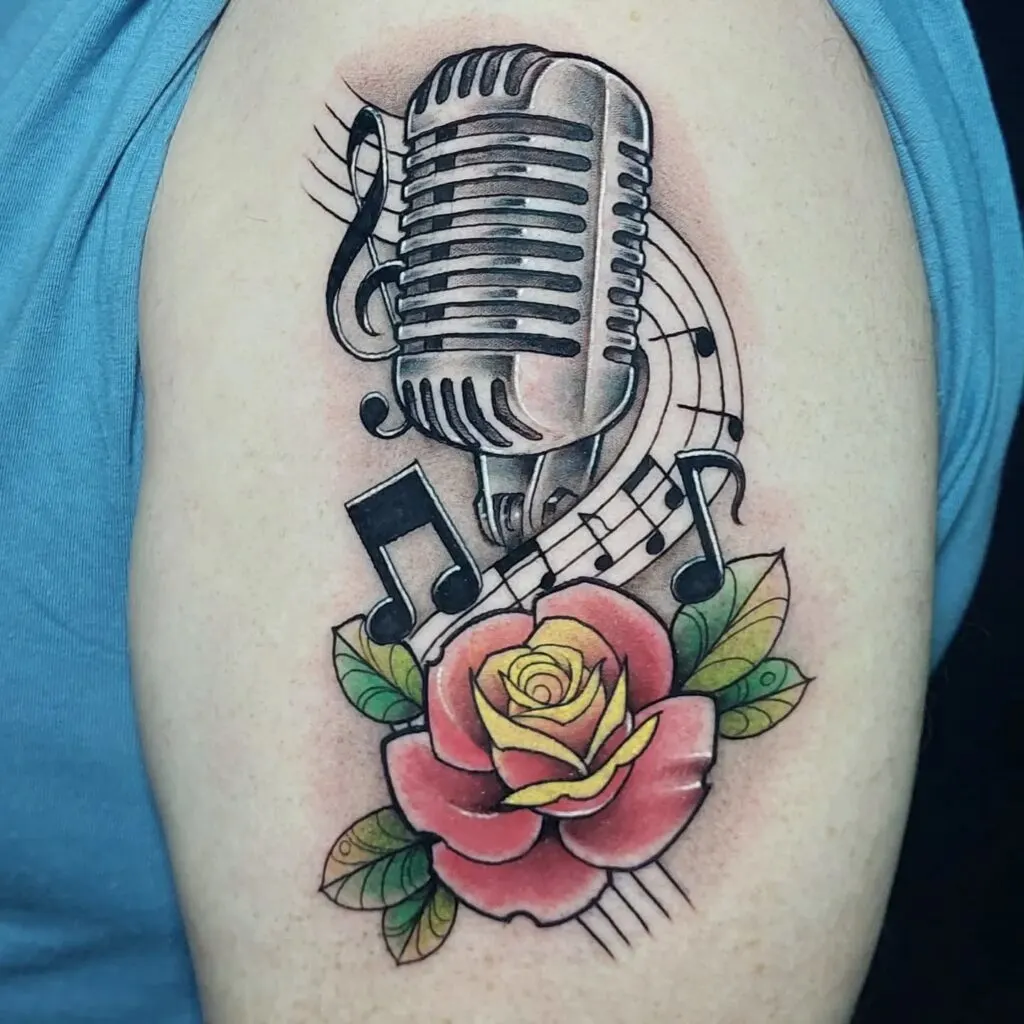
Perfect for musicians, composers, or those with a profound connection to a particular melody, sheet music tattoos symbolize a deep appreciation for the technical and emotional aspects of music. Whether spanning the forearm, wrapping around the wrist, or adorning the shoulder, these tattoos are timeless tributes to the universal language of music and its lasting impact.
9. Microphones
Microphone tattoos are a popular choice for singers, performers, and those who find their voice through music. These designs symbolize a passion for self-expression and a deep connection to the world of melodies and rhythm. Often depicted in classic styles with intricate details like vintage microphones or modern studio designs, these tattoos celebrate the power of music to connect, inspire, and communicate.
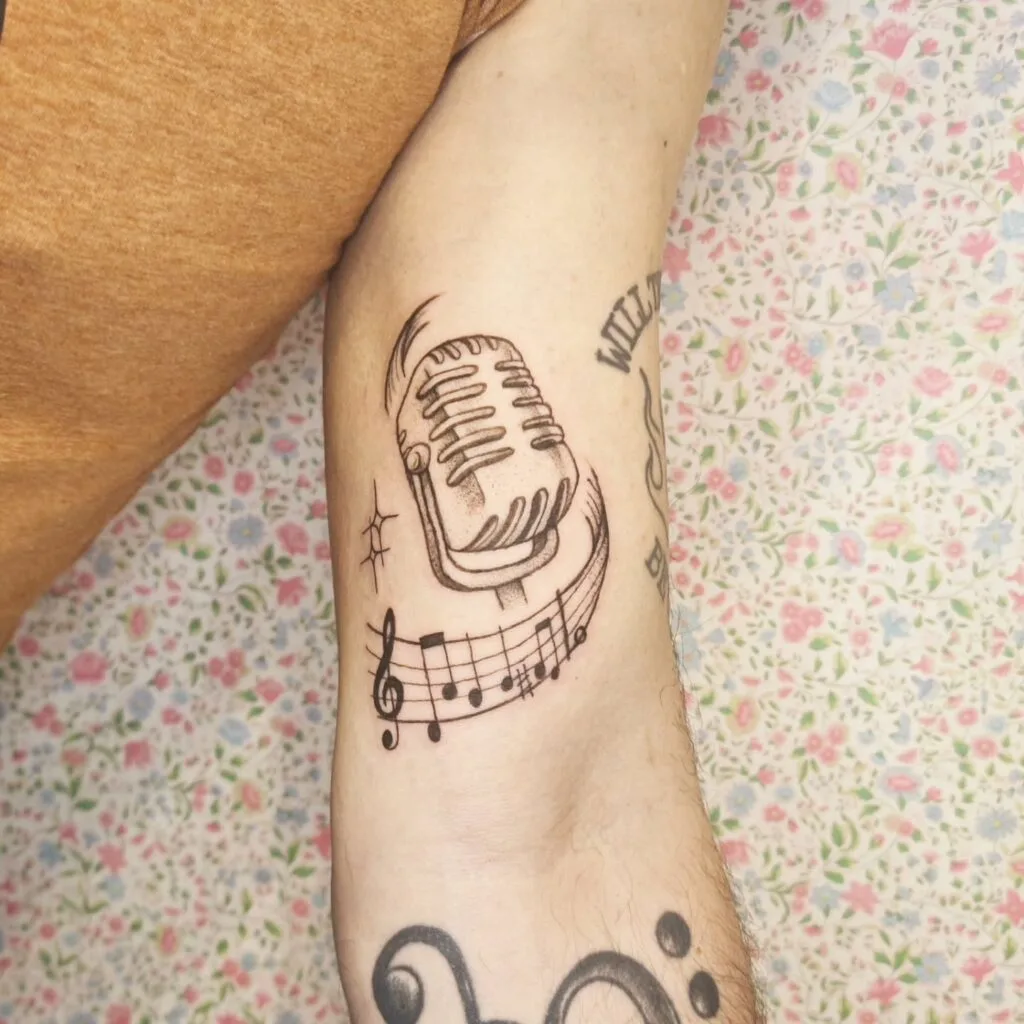
Microphones can be paired with musical notes, soundwaves, or lyrics for added personalization. Perfect for placement on the forearm, shoulder, or hand, microphone tattoos are a striking tribute to the art of sharing one’s voice and talent with the world.
Tattoo Placement Ideas for Music Tattoos
The placement of a music tattoo plays a crucial role in its visibility, aesthetic, and personal significance. Here are some placement ideas to consider:
1. Arms
- Forearm: Perfect for showcasing detailed designs like sheet music, instruments, or lyrics.
- Biceps: Great for larger designs, like microphones or band logos, with a bold and prominent look.
- Wrist: Ideal for smaller tattoos like musical notes, symbols, or minimalist soundwaves.
2. Hands and Fingers
- Knuckles: Suited for tiny designs like musical notes or initials of favorite bands.
- Side of Fingers: Perfect for discreet, minimal tattoos like treble clefs or small lyrics.
3. Chest
- A popular choice for larger, meaningful tattoos, such as intricate compositions, soundwaves, or band logos. The chest provides a wide canvas for detailed designs.
4. Back
- Ideal for expansive designs like full sheet music, a collage of instruments, or a tribute to a band or artist. The back allows for creativity and complexity.
5. Legs
- Thighs: Great for larger tattoos like full lyrics, detailed instruments, or intricate mandala-style music tattoos.
- Calves: A good choice for designs that are medium-sized, such as soundwaves or band logos.
6. Neck
- For smaller, bold designs like musical notes, treble clefs, or minimalist logos, the neck is perfect for an edgy and stylish look.
7. Behind the Ear
- A subtle and unique spot for tiny designs like musical notes or a soundwave, perfect for music lovers who prefer discreet tattoos.
8. Ankles and Feet
- Great for small and personal designs, such as simple notes, symbols, or small headphones.
1
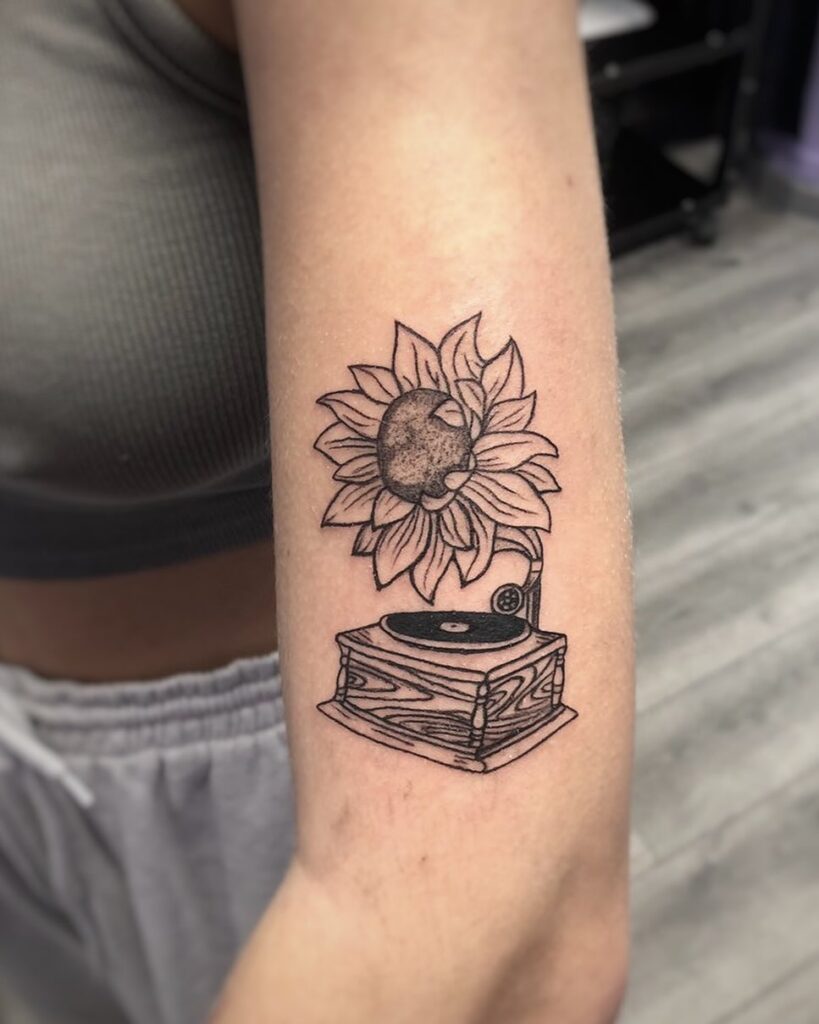
2
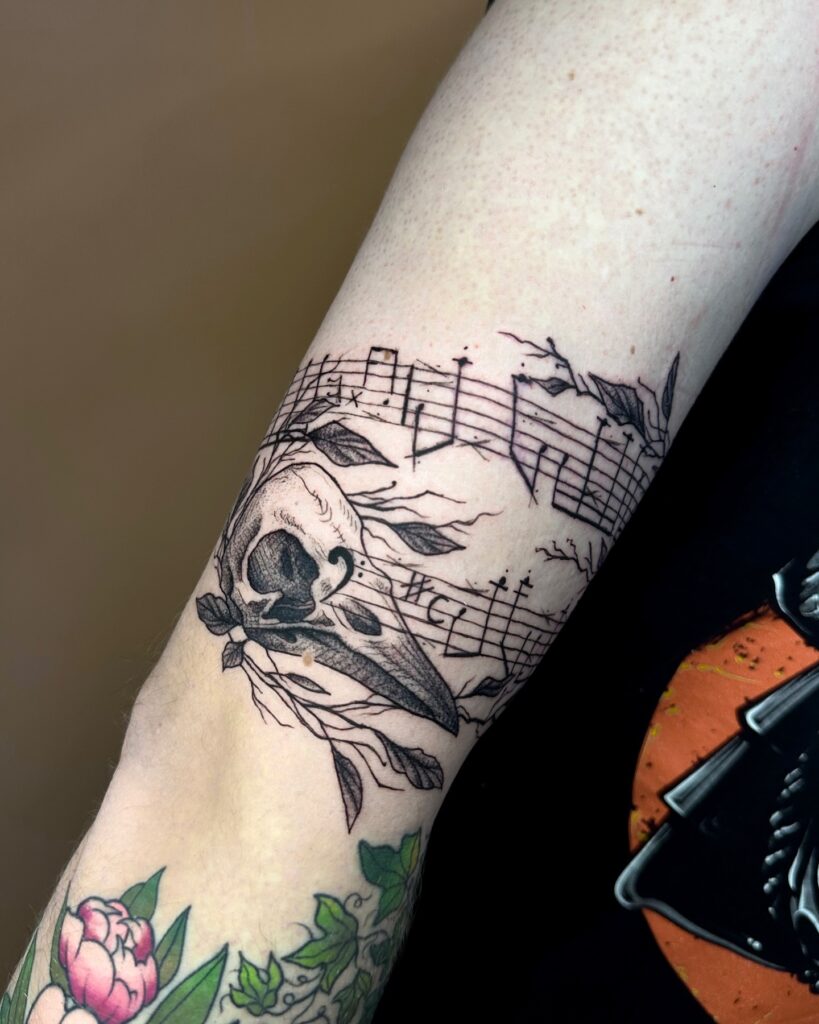
3
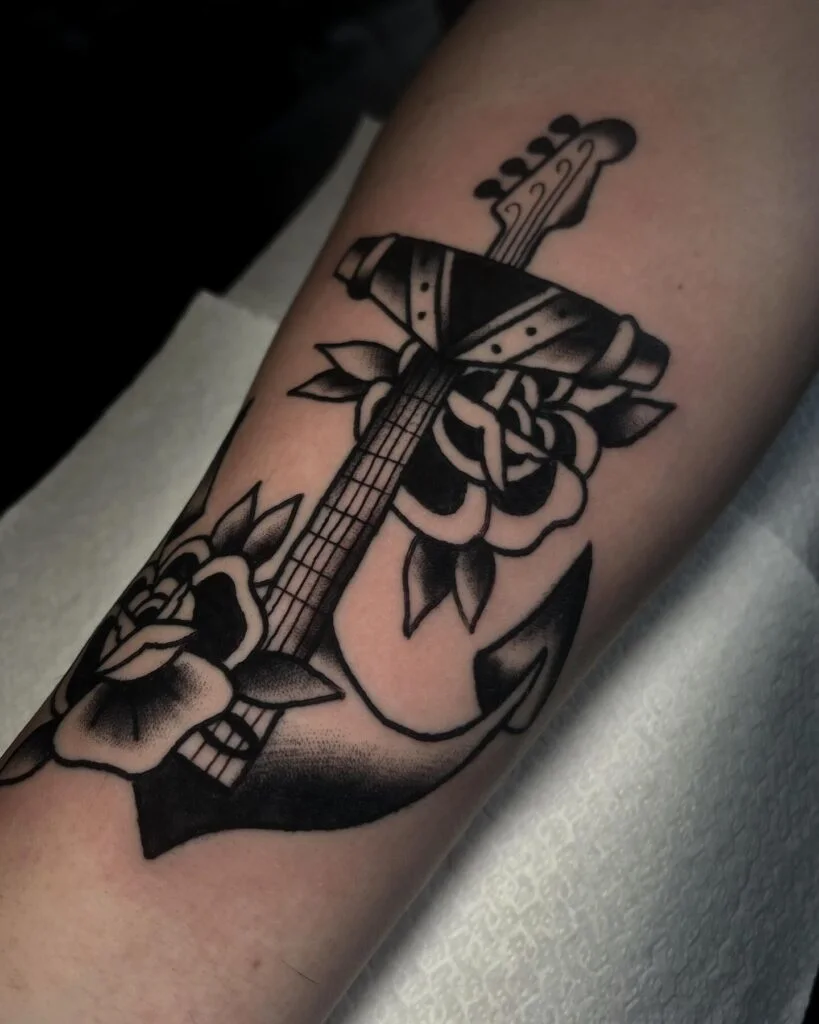
4
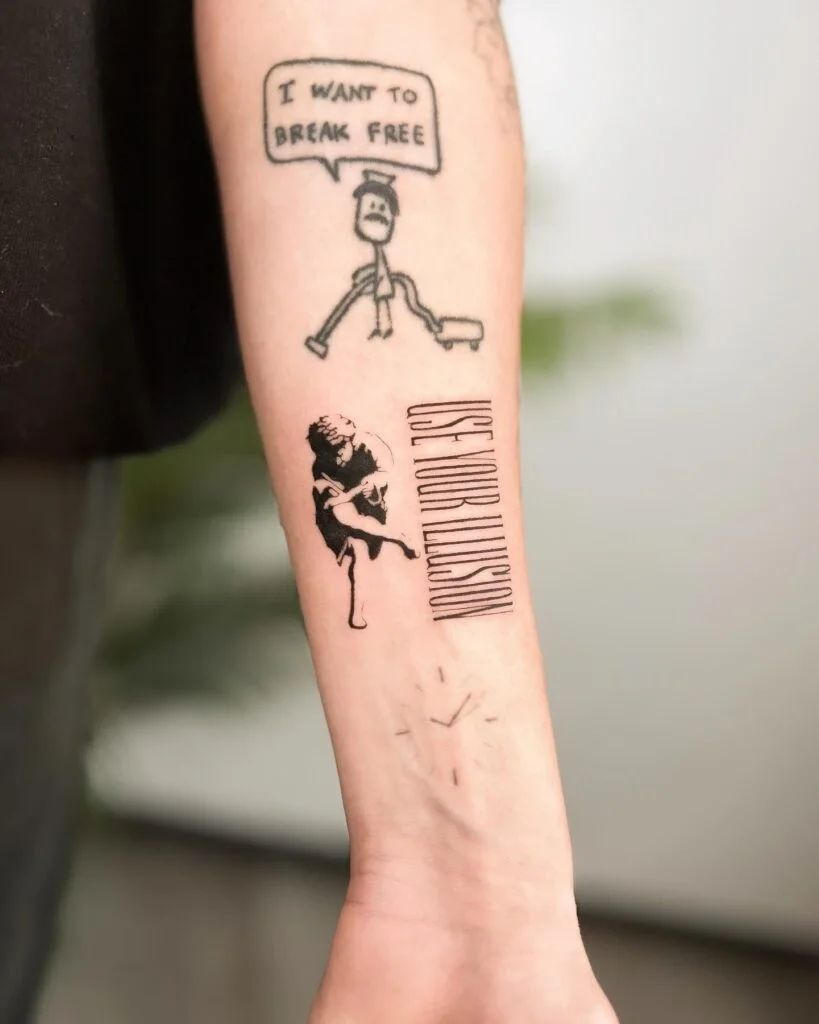
5
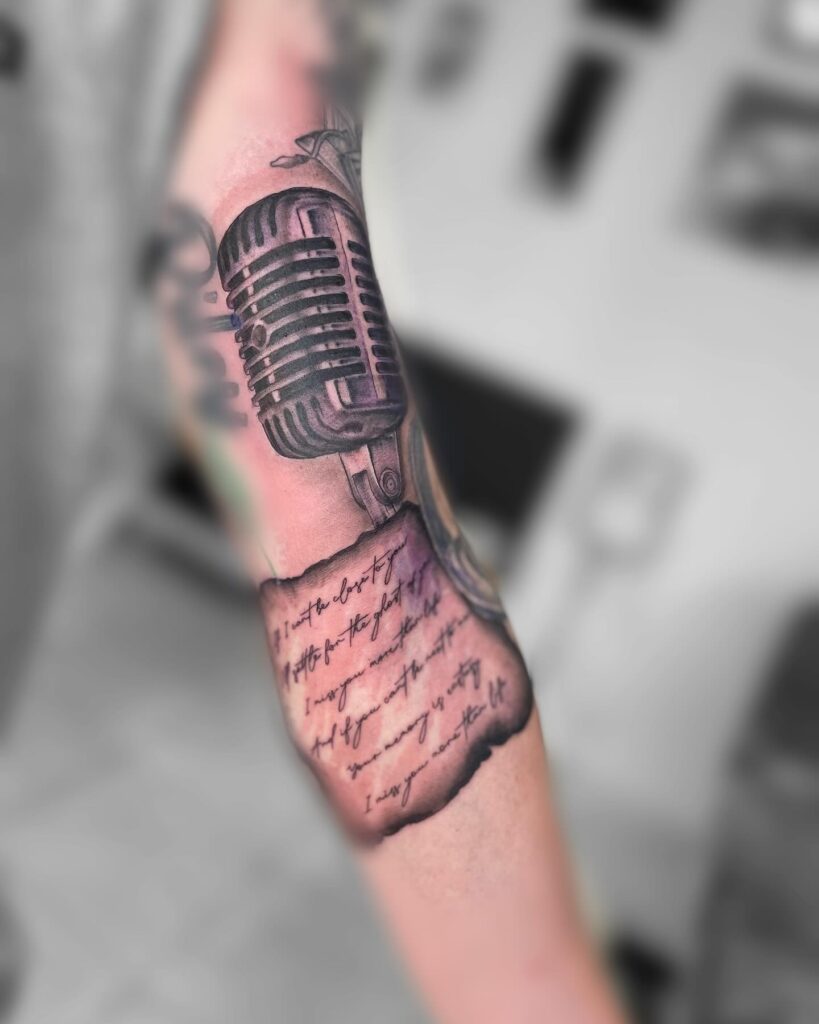
6
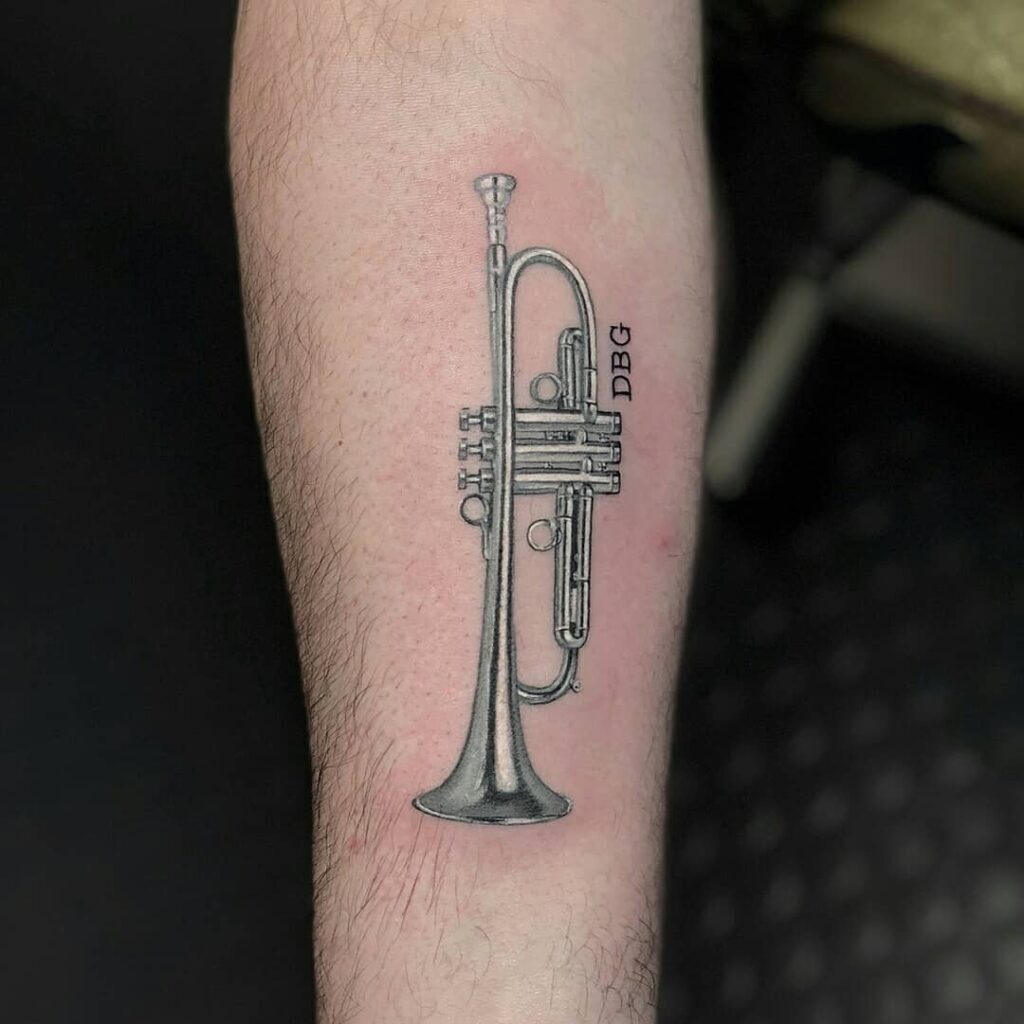
7

8
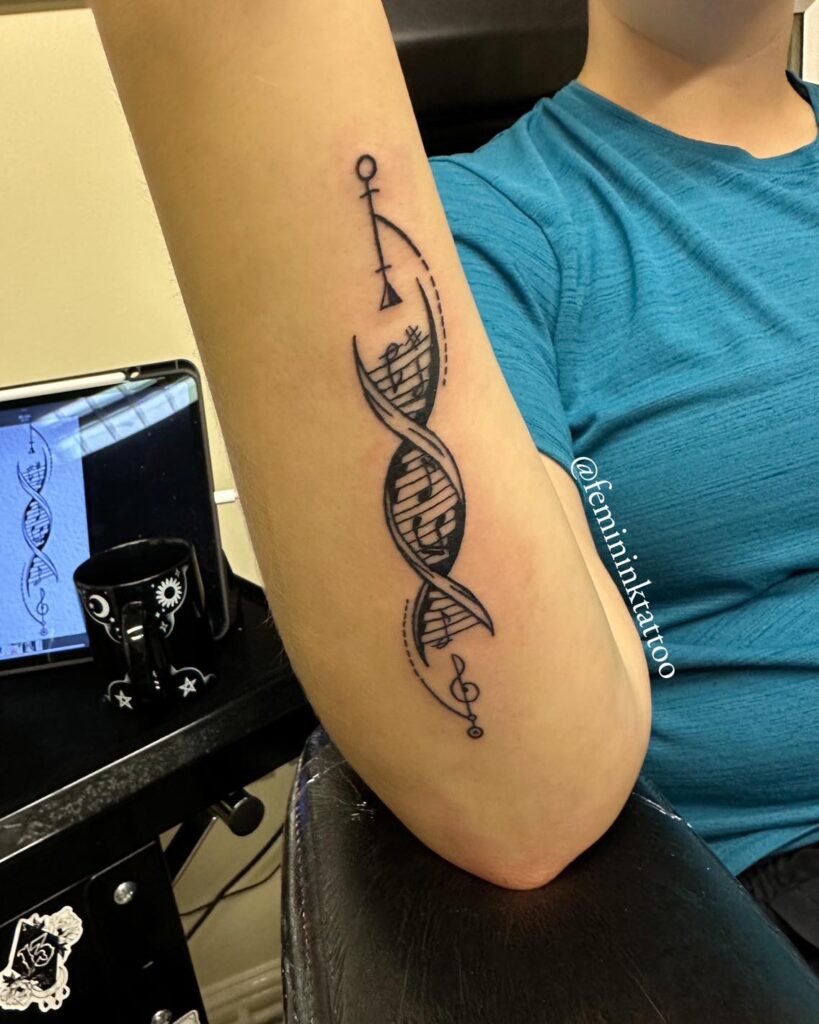
9
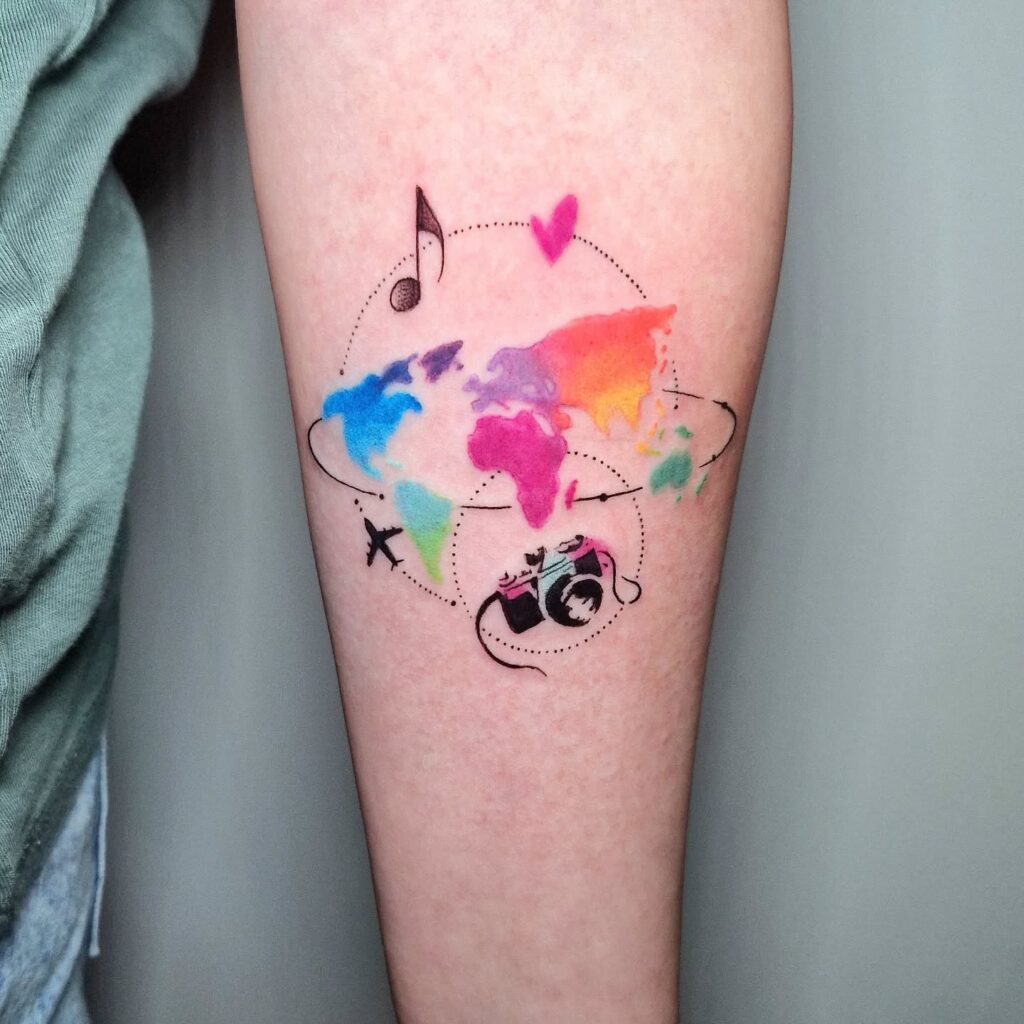
Tattoo Aftercare Tips for Music Tattoos
Proper aftercare is essential to keeping your music tattoo vibrant and sharp—especially if it contains delicate lines, fine shading, or intricate fonts. The healing process impacts not only how your tattoo looks but also how it ages over time.
Follow your artist’s instructions first. They may recommend a specific ointment or bandage type based on their style. Trust their expertise and don’t deviate unless necessary.
Keep it clean and moisturized. Gently wash the area with mild, fragrance-free soap, then pat dry with a soft towel. Apply a light layer of aftercare ointment or tattoo lotion. Don’t overdo it—too much moisture can hinder healing.
Avoid sun and water. Keep your tattoo out of direct sunlight and away from pools, hot tubs, or any bodies of water for at least two weeks. UV rays can fade your tattoo, and water exposure can cause infection.
No picking or scratching. As your tattoo heals, it will likely scab and itch. Picking at it can damage lines and shading, leading to patchiness or infection. Instead, tap gently if it itches or apply a soothing lotion.
Wear loose clothing. Tight fabric can rub against your tattoo and irritate it, especially during the first few days. Go for breathable, soft materials that won’t stick to your skin.
Good aftercare will help your music tattoo stay crisp and expressive—just like your favorite song played at full clarity.
Final Thoughts
Music tattoos are deeply personal and powerful. Whether you’re honoring a favorite artist, capturing a transformative song, or simply expressing your love for sound, these tattoos offer a timeless form of self-expression.
As with any meaningful ink, it’s important to take your time choosing the right design, placement, and artist. Music is emotional, nostalgic, and ever-evolving—and your tattoo should reflect that same spirit. Think beyond trendy icons and choose something that truly resonates with your story.
Your tattoo becomes a permanent note in your life’s melody—a visual beat in the rhythm of who you are. When designed with intention and cared for with love, music tattoos are not just art on the skin but a harmony of soul, sound, and self.
Frequently Asked Questions
1. What are the most popular music tattoo designs?
Some of the most common music tattoo designs include treble and bass clefs, musical notes, instruments (guitar, piano, violin), soundwaves, sheet music, and lyrics. These designs can be as minimal or detailed as you like.
Lyrics tattoos are especially popular, often taken from songs that hold personal meaning. Whether it’s a line that reminds you of a loved one or a phrase that helped you through a hard time, lyrics become lifelong reminders of your emotional journey.
Soundwave tattoos have also gained popularity—they use audio snippets from a favorite song or voice message, often scannable via apps, making the tattoo interactive and even more meaningful.
Minimalist music tattoos are ideal for first-timers, while full pieces featuring instruments, band logos, or creative portraits work well for those who want a bolder statement. Whatever the style, the most meaningful music tattoos are the ones that feel personal and timeless to you.
2. Can I get a tattoo of a copyrighted song lyric?
Technically, yes—you can tattoo copyrighted lyrics on your body. However, it’s important to understand the legal and ethical implications, especially if you plan to reproduce or publish the design (like on merchandise or commercial artwork).
For personal use, copyright laws are rarely enforced, and many people get small excerpts of lyrics that hold personal meaning. Still, if you’re including a large portion of a song or planning to sell the design later, you could run into issues.
To stay respectful, consider contacting the artist or publisher if you want to include large lyric sections. Alternatively, a great workaround is choosing a symbolic representation of the lyrics, such as an abstract design, a single word, or a visual that captures the same feeling.
Work with a tattoo artist who understands design limitations and knows how to subtly incorporate text or stylize it in a unique way. That way, your tattoo remains both beautiful and original while honoring the music that inspired it.
3. What do soundwave tattoos represent, and how do they work?
Soundwave tattoos represent a visual imprint of a specific sound—usually a voice, song, or moment that holds emotional value. They’re often created by recording a phrase or clip, converting the audio into a waveform, and using that shape as the tattoo design.
What makes soundwave tattoos particularly special is that some can be scanned using apps (like Skin Motion), allowing the tattoo to “play” the original sound. This makes them highly personal, often used to memorialize loved ones’ voices, meaningful messages, or song snippets.
Design-wise, soundwave tattoos are minimalist and abstract. They work well on the forearm, wrist, or upper arm and can be styled in various ways—horizontal, vertical, with text, or integrated into larger designs.
If you’re considering one, make sure your artist can replicate fine detail accurately. Also, verify the waveform format with any app you plan to use for playback. A little preparation ensures your soundwave tattoo remains both visually striking and emotionally powerful.